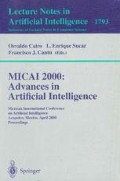Abstract
The Principal Components Analysis (PCA) is one of the most successfull techniques that have been used to recognize faces in images. This technique consists of extracting the eigenvectors and eigenvalues of an image from a covariance matrix, which is constructed from an image database. These eigenvectors and eigenvalues are used for image classification, obtaining nice results as far as face recognition is concerned. However, the high computational cost is a major problem of this technique, mainly when real-time applications are involved. There are some evidences that the performance of a PCA-based system that uses only the region around the eyes as input is very close to a system that uses the whole face. In this case, it is possible to implement faster PCA-based face recognition systems, because only a small region of the image is considered. This paper reports some results that corroborate this thesis, which have been obtained within the context of an ongoing project for the development of a performance assessment framework for face recognition systems. The results of two PCA-based recognition experiments are reported: the first one considers a more complete face region (from the eyebrows to the chin), while the second is a sub-region of the first, containing only the eyes. The main contributions of the present paper are the description of the performance assessment framework (which is still under development), the results of the two experiments and a discussion of some possible reasons for them.
Access this chapter
Tax calculation will be finalised at checkout
Purchases are for personal use only
Preview
Unable to display preview. Download preview PDF.
References
Chellappa, R., Wilson, C.L., Sirohey, S.: Human and machine recognition of faces: a survey. In: Proceedings of the IEEE, vol. 83(5), pp. 705–640 (1995)
Moghaddam, B., Pentland, A.: Face Recognition using View-Based and Modular Eigenspaces. In: Proc. of Automatic Systems for the Identification and Inspection of Humans, vol. 2277, SPIE, San Jose (1994)
Brunelli, R., Poggio, T.: Face recognition: features versus templates. IEEE Transactions on Pattern Analysis and Machine Intelligence 15(10), 1042–1052 (1993)
Romdhani, S.: Face recognition using principal conponents analysis., MSc Thesis, Department of Electronics and Electrical Engineering, University of Glasgow, (March 13 1996)
Valentin, D., Abdi, H., O’Toole, A.J.: Principal component and neural network analyses of face images: Exploratinos into the nature of information available for classifying faces by Sex. In: Dowling, C., Roberts, F.S., Theuns, P. (eds.) Progress in Mathematical Psychology, Erlbaum, Hillsdale (in press)
Castleman, K.R.: Digital Image Processing. Prentice-Hall, Englewood Cliffs (1996)
Silva, L., Aizawa, K., Hatori, M.: Detection and tracking of facial features. In: Proc. Of SPIE Visual Communications and Image Processing 1995 (VCIP 1995), Taipei, Taiwan, May 1995, pp. 2501/1161-2501/1172 (1995); Awarded the SPIE (The International Society for Optical Engineering) Best student paper.
Rowley, H.A., Baluja, S., Kanade, T.: Neural Network based Face Detection. IEEE Transactions on Pattern Analysis and Machine Intelligence 20(1), 23–38 (1998)
La Cascia, M.: e S. Sclaroff, “Fast, Reliable Head Tracking under Varying Illumination”, Technical Report, Boston University BU CS TR98-018. To appear in Proc. IEEE CVPR 1999 (1999)
Jain, A., Zongker, D.: Feature Selection: Avaluation, Application, and Samall sample Performance. IEEE Transacrions on Pattern Analysis and Machine Inteligence 19(2), 153–158 (1997)
Perlovsky, L.I.: Conundrum of Combinatorial Complexity. IEEE Transacrions on Pattern Analysis and Machine Inteligence 20(6), 666–670 (1998)
Craw, N.C., Kato, T., Akamatsu, S.: How Should We Represent Faces for Automatic Recognition? IEEE Transactions on Pattern Analysis and Machine Intelligence 21(8), 725–736 (1999)
Author information
Authors and Affiliations
Editor information
Editors and Affiliations
Rights and permissions
Copyright information
© 2000 Springer-Verlag Berlin Heidelberg
About this paper
Cite this paper
de Campos, T.E., Schmidt Feris, R., Marcondes, R.C. (2000). Eigenfaces Versus Eigeneyes: First Steps Toward Performance Assessment of Representations for Face Recognition. In: Cairó, O., Sucar, L.E., Cantu, F.J. (eds) MICAI 2000: Advances in Artificial Intelligence. MICAI 2000. Lecture Notes in Computer Science(), vol 1793. Springer, Berlin, Heidelberg. https://doi.org/10.1007/10720076_18
Download citation
DOI: https://doi.org/10.1007/10720076_18
Publisher Name: Springer, Berlin, Heidelberg
Print ISBN: 978-3-540-67354-5
Online ISBN: 978-3-540-45562-2
eBook Packages: Springer Book Archive

